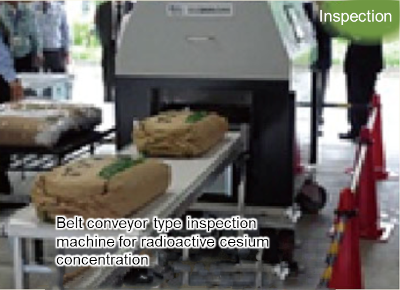Information Disclosure
(2020)
QAre foods from Fukushima safe?
AFukushima Prefecture and other institutions continue inspections of radioactive cesium concentrations in food. This ensures that foods with radioactive cesium concentrations exceeding the 100 Bq/kg limit for the general food products are not distributed on the market.
In particular, 100% inspection of unpolished rice continued from FY2012 to FY2019. Among more than 900 batches annually inspected since FY2015, none exceeded the above limit. Based on this outcome, 100% inspection was replaced by sampling inspection in FY2020 except in municipalities under evacuation orders.
(Fukushima Prefecture: Announcement on rice monitoring inspection)

Fig.1 100% inspection of rice (Fukushima Prefecture)
Other foods are also routinely inspected, and the results are published on the websites of Fukushima Prefecture and other institutions.
Annual exposure doses from foods have been confirmed to be well below 1 mSv through surveys using the market basket method, which measures individual food items available on the market, and the duplicate diet method, which directly measures meals being served.

Fig.2 Estimated internal exposure dose from foods
(Hiromi Nabeshi, Division of Foods, National Institute of Health Sciences)
Related articles
- In what ways does exposure to radiation occur the environment? What kinds of radiation exposures are important in Fukushima?
- How is radioactivity in foods measured? What are the radiation doses from foods?
- How is radioactivity measured in drinking water? What are the results?
- How can we evaluate radioactive material taken inside our body?
- What is the current concentration of radioactive cesium in edible wild plants in Fukushima Prefecture?
